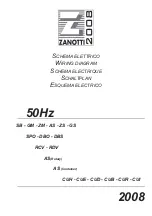
4. HOW TO DEAL WITH CLAIMS
4-1. Sound
TROUBLE DIAGNOSIS
- 1
31
-
Problems
Checks and Measures
"Whizz" sounds
■
Explain general principles of sounds.
• All refrigerator when functioning properly have normal operating sound. The
compressor and fan produce sounds.
There is a fan in the freezer compartment which blows cool air to freezer and
refrigerator compartments. "Whizz" sounds are heard when the air passes
through the narrow holes into the freezer and refrigerator compartments.
■
Cooling Fan sound in the compressor compartment.
• There is a fan on the back of the refrigerator, which cools the compressor
compartment. If there is a small space between the refrigerator and the wall, the
air circulation sounds may be noticeable.
■
Noise of Compressor.
• This operating sound happens when the compressor compresses the
refrigerant. The compressor rotates at 3600RPM. The sound of compressor
operation becomes louder as the refrigerator capacity increases.
"Click" sounds
■
Explain the principles of temperature change.
• The sounds happens when pipes and internal evaporator in the refrigerator
compartment expand and contract as the temperature changes during the
refrigerator operation. This sound also happens during defrosting, twice a day,
when the ice on the evaporator melts.
"Clunk" sound
■
Explain that it comes from the compressor when the refrigerator starts.
• When the refrigerator operates, the piston and motor in the compressor rotate
at 3600RPM. This sound is caused by the vibration of motor and piston when
they start and finish their operation. This phenomena can be compared with that
of cars. When the car engine ignites and starts to rotate, the loud sound
becomes gradually quiet. When the engine stops, it stops with vibration.
Vibration sound
■
Check the sound whether it comes from the pipes vibration and friction.
• Insert rubber or leave a space between pipes to avoid the noise.
• Fix the fan blade if the noise is due to the collision of fan and shroud.
• Fix the drip tray if it is loosened.
■
Sound depends on the installation location.
• Sound becomes louder if the refrigerator is installed on a wooden floor or near a
wooden wall. Move it to the another location.
• If the refrigerator is not leveled properly, a small vibration can make a loud
sound. Please adjust the level of the refrigerator.
Summary of Contents for GC-L207TLQK.CGSQSTG
Page 23: ...EXPLATION FOR MICOM CIRCUIT 32 GC P L207 88 LED GC P L207 Bar LED GC P L207 Dot LED ...
Page 28: ...1 5 Temperature sensing circuit EXPLATION FOR MICOM CIRCUIT 28 GC L207 Bar LED F C A B D ...
Page 32: ...EXPLATION FOR MICOM CIRCUIT 50 GC P L207 Bar LED GC P L207 Dot LED b a e d b a e d ...
Page 38: ...EXPLATION FOR MICOM CIRCUIT 62 GC P L207 Bar LED ...
Page 39: ...EXPLATION FOR MICOM CIRCUIT 68 GC P L207 Bar LED ...
Page 40: ...EXPLATION FOR MICOM CIRCUIT 69 GC P L207 Bar LED ...
Page 41: ... GC P L207 Bar LED EXPLATION FOR MICOM CIRCUIT 78 ...
Page 42: ...EXPLATION FOR MICOM CIRCUIT 79 PWBASSEMBLY DISPLAY ...
Page 49: ...CIRCUIT 94 GC P L B C207 Bar LED The circuit has been only applied to voltage except 220v ...
Page 100: ......
















































